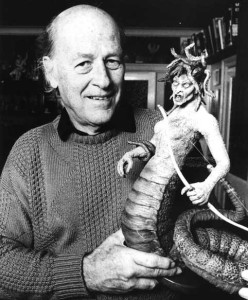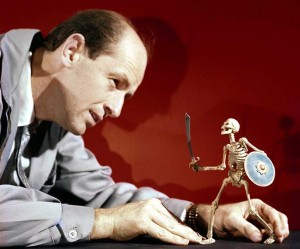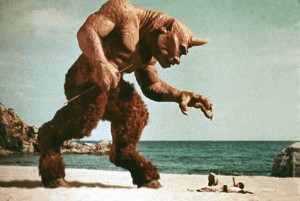![]()
 Much has now been written about Ray Harryhausen, the singular puppet animation technician, who died this week at the age of 92. Over the years, there have been a mountain of articles, interviews, books, documentaries and museum exhibits which have illuminated his lauded career achievements, spanning more than 40 professional years and igniting the imaginations of generations of young viewers.
Much has now been written about Ray Harryhausen, the singular puppet animation technician, who died this week at the age of 92. Over the years, there have been a mountain of articles, interviews, books, documentaries and museum exhibits which have illuminated his lauded career achievements, spanning more than 40 professional years and igniting the imaginations of generations of young viewers.
After being amazed as a preteen audience member for 1933’s King Kong, Harryhausen engaged in numerous amateur experiments using Kong animator Willis O’Brien’s stop-motion animation techniques. Eventually, he produced a series of short films based on classic fairy tales. An introduction to O’Brien led to Harryhausen working as the key stop-motion animator working under O’Brien in 1949’s Mighty Joe Young. For that project, Harryhausen developed many of the title character’s idiosyncratic behaviors, such as when the giant gorilla would pound the ground in anger, a Harryhausen staple which would inform many of his future films.
Surely O’Brien came first and created the basis by which Harryhausen would succeed, but while O’Brien had many personal and professional disappointments with a slew of projects which were never produced, Harryhausen took O’Brien’s methods and produced a still-unmatched slate of stop-motion-animated fantasy films of the 1950s, 1960s and 1970s, ending in 1981.

Though Harryhausen was not a credited producer on his first feature film as a chief technician, The Beast from 20,000 Fathoms, that landmark film, released 60 years ago, began an unprecedented run by an individual craftsperson and filmmaker. With partner Charles Schneer after that point, Harryhausen regularly created his magical films, both providing the memorable “dynamation” for his characters and rendering unforgettable creations in every film through this period. Primary among Harryhausen’s myriad unmistakable characters in the early years were the Ymir from 1957’s 20 Million Miles to Earth, the Cyclops in 1958’s The 7th Voyage of Sinbad and the skeleton army from 1963’s Jason and the Argonauts.
Not only were these films remarkable for their considerable artistic and technical achievement, they were perhaps unknowingly inspiring a legion of boys to create their own films and creatures; many of these awestruck kids would become award-winning filmmakers themselves in the decades ahead. In fact, 7th Voyage specifically has often been named as the one film, which coalesced the dreams of a horde of Baby Boomers, prompting them to initiate their own creative endeavors.
After the success of Argonauts, Harryhausen might have been considered passé in some circles, especially in an era of increasingly verité-style films. Yet, he continued with his pursuits, never veering from his predilection toward extraordinary stop-motion-animated characters in films, including The Valley of Gwangi in 1969. In the mid-1970s, Harryhausen might have made something of a comeback with two new Sinbad films, aimed at an entirely new audience than his original one: The Golden Voyage of Sinbad in 1973 and Sinbad and the Eye of the Tiger in 1977, his penultimate film. Those newer classics featured more stunning character work, with each film delivering more newly-conceived set pieces. For one, Golden Voyage’s battle between the Griffin and the Centaur was as compelling as anything in Harryhausen’s previous filmography. Then, Eye of the Tiger featured a stop-motion-animated baboon, which delivered as much lifelike primate behavior as Mighty Joe and Kong had in each of their eras.

Eventually, the enormous workload of producing stop-motion animated films with such attention to detail mandated a relatively early retirement. Hence, Clash of the Titans, which Harryhausen finished when he was 60, was his final film. Released in 1981, Titans left audiences with one final piece of magical Harryhausen character work, from set pieces with giant scorpions, to recurring scenes with a cursed demonic prince, to a definitively designed and animated Medusa.
Many of Harryhausen’s films were shot on-location in Spain and England where he had established permanent homes and resided thereafter, though he routinely visited his native Los Angeles during his three-decade retirement. Both Harryhausen and his breadth of special films will always hold a marked place in the hearts of his sizable international audiences. His lasting legacy will be in the close-up faces of his iconic characters. These timeless beasts have graced screens and televisions for more than six decades and will continue to do so for generations to come.





